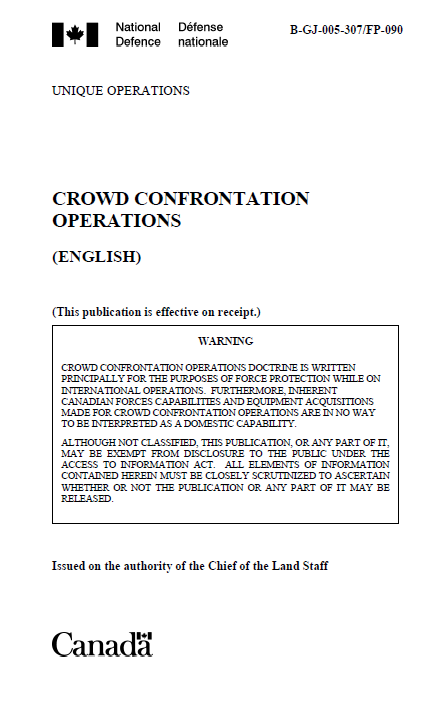 B-GJ-005-307/FP-090
B-GJ-005-307/FP-090
- 192 pages
- CROWD CONFRONTATION OPERATIONS DOCTRINE IS WRITTEN PRINCIPALLY FOR THE PURPOSES OF FORCE PROTECTION WHILE ON INTERNATIONAL OPERATIONS. FURTHERMORE, INHERENT CANADIAN FORCES CAPABILITIES AND EQUIPMENT ACQUISITIONS MADE FOR CROWD CONFRONTATION OPERATIONS ARE IN NO WAY
TO BE INTERPRETED AS A DOMESTIC CAPABILITY. - ALTHOUGH NOT CLASSIFIED, THIS PUBLICATION, OR ANY PART OF IT, MAY BE EXEMPT FROM DISCLOSURE TO THE PUBLIC UNDER THE ACCESS TO INFORMATION ACT. ALL ELEMENTS OF INFORMATION CONTAINED HEREIN MUST BE CLOSELY SCRUTINIZED TO ASCERTAIN WHETHER OR NOT THE PUBLICATION OR ANY PART OF IT MAY BE RELEASED.
- October 2003
SCOPE
3. This manual is based on the precept that crowd confrontation
situations could occur on any CF operation. The doctrine has been
designed to facilitate the use of CCO as a unique operation, which
may be a subset of any other CF operation. Where peace support
operations (PSO), domestic operations, or armed conflict examples are
used, the concepts presented are intended to cover all operations. The
manual stresses that the CCO hierarchy can be applied during any
operation to assist in the decisions of what equipment to acquire or
deploy and what training is to be based on. It provides the tools to
train and equip deployed forces to successfully control and disengage
themselves from crowd confrontation situations while ensuring
mission success, without having to resort solely to the use of deadly
force. CCO is envisaged as being applicable across the spectrum of
conflict and throughout the continuum of operations.4. Chapter 1 deals specifically with the legal aspects related to
CCO. Chapter 2 provides an introduction to the background of CCO
and explains the hierarchy associated with this type of Unique
Operation. It also outlines where CCO fits within the CF operational
hierarchy. It further describes the approach toward CCO, and
highlights the relationships with the Army’s combat functions.
Chapter 3 deals with the specific terminology of CCO and the nature
of crowds. Chapter 4 explains the planning process associated with
CCO. Force organization considerations and possible tactical
formations are also presented in Chapter 4. Chapter 5 deals
specifically with the practical considerations of conducting CCO,
including techniques to influence crowds, along with the CCO
hierarchy. Chapter 6 introduces some particular specialized
equipment considerations for CCO and amplifies the use of non-lethal
weapons in the conduct of operations. Equipment-specific drills are
not included in this manual. The intent is that these would be
promulgated separately. Key terms and abbreviations, used in this
publication, are found in the Glossary at Annex A. Finally Annexe B
provides tactical aide-mémoires that will be useful in a CCO.…
APPENDIX 5
AIDE-MÉMOIRE FOR SEARCHING VEHICLES
INTRODUCTION1. Legal Considerations. There are significant legal issues
relating to searches of vehicles and their occupants. Searches must
only be conducted in accordance with the appropriate orders and
applicable law. The following procedures shall only be conducted
when lawful authority has been established for the search of vehicles
and their occupants.2. General. When troops are ordered to undertake searches, the
objects or persons for which the troops are to search must be made
clear. Indiscriminate searching must be avoided as it wastes time and
resources. Commanders shall ensure that they have an authority in
law prior to commencing any search. Normally, special search teams
drawn from the engineers, will be trained to conduct detailed searches
of vehicles.3. In conducting their activity hostile groups are almost certain
to use all types of vehicle to move their resources. The search of
vehicles at vehicle checkpoints (VCPs) deters movement and
furthermore, when finds are made, they can be attributed to individuals
thereby enhancing the chances of a successful prosecution. The large
numbers of vehicles on the roads today can make the search of cars at
VCPs appear a daunting task. If it is not to rely on chance, searching
of vehicles must be backed up by an efficient intelligence system,
which targets vehicles and enables data on them to be quickly verified.
This involves close liaison with police records, vehicle registration
authorities, etc. Nevertheless, the alertness and intuition of the
policeman or soldier on the spot can achieve much. He should be
aware of the general characteristics of a vehicle’s construction and the
signs that may indicate that the vehicle is suspect and therefore not
legitimate.…
9. The Sequence of Checking. It is not necessary for the full
sequence to be completed on all vehicles. The parts applied should
vary from vehicle to vehicle, to keep an insurgent guessing. Checking
should be stopped once the integrity of the passengers and contents of
the vehicle are assured. Nevertheless, in general, vehicles should be
systematically searched from front to rear as follows:a. sun visors, glove compartment, and cubby holes;
b. behind dashboard (wires leading from instruments
may conceal a small weapon or document);
c. under driver’s seat, and between driver and
passenger seats;
d. back of driver seat, i.e., between back of seat and
bottom of back rest;
e. door pockets, and underneath movable mats and
back seats;
